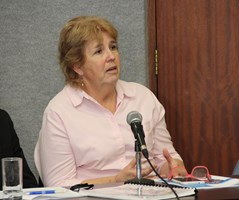Shifting the way we do it: sharing different methods for clinical practice guideline adaptation for use in South Africa
Thursday, 12 Oct 2017New clinical practice guideline (CPG) development is expensive and time-consuming and therefore often unrealistic with limited funding or resources. There is also no point in developing new guidelines when there is are accessible, good-quality guidelines available to fit local needs. Various methods exist to adopt, adapt or contextualise guidelines from one setting to another. These development methods are a key vehicle for formal guideline teams, clinicians and decision makers to produce contextually relevant and robust guidance for their healthcare setting.
The SAGE project therefore held a workshop in April to provide an opportunity for dialogue regarding different approaches to guideline development with key examples from the South African setting.
The objectives were:
-
to share different approaches for adapting CPGs;
-
to outline the challenges and lessons learnt;
-
to discuss the approaches that South African teams use when developing guidelines.
The workshop included four presenters all whom have been involved in guideline development in South Africa to share their experiences, the methodologies used, as well as the challenges and lessons learned.
Dr Bev Draper, who consults as a public health specialist for the National Department of Health in the field of guideline development, presented on the development of a health-promotion tool for use in primary healthcare that addresses health risks and existing chronic disease conditions, as well as a training package for its implementation.
“Good graphics are an essential part of the end product – pictures are often more powerful than text,” said Dr Draper. “The final design needed to be robust and practical for the clinical setting – therefore a hard-cardboard design was used that could stand on a desk for easy access.”
“It’s also extremely important that health messages are carefully selected, refined and aligned with the local context, and are user-friendly and culturally appropriate,” she added.
Dr Dawn Erntzen, a Senior Lecturer in Physiotherapy at Stellenbosch University presented on the development of a contextualised evidence-based CPG for the primary healthcare of chronic musculoskeletal pain in the Western Cape, South Africa.
She pointed to the challenge of finding appropriate, understandable wording for healthcare workers with different education levels. She emphasised that contextualising for the South African setting is very important, as is ensuring the appropriate composition and skill set of the development panel, and added that “Implementation remains challenging and sometimes controversial in the South African context.”
Michael McCaul is a registered emergency care practitioner currently working as a researcher at the Biostatistics Unit at Stellenbosch University. He presented on pre-hospital emergency care CPGs for the South African Emergency Medical Services.
“Not all available guidelines are of equal quality,” he said. “The levels of evidence classification are not necessarily homogenous.”
“It’s therefore important to search other sources not only primary-level evidence for CPGs,” he continued.
McCaul also pointed to the poor transition from guidelines to clinical practice and emphasised the importance of implementation and training aspects.
Dr Henk Temmingh, who is a consultant psychiatrist in the acute admissions unit at Valkenberg Psychiatric Hospital and Lecturer in the Department of Psychiatry and Mental Health at the University of Cape Town, presented on guidelines for the management of severe mental disorders with co-morbid substance misuse in South African psychiatric settings.
“Lack of time was a huge challenge,” he said. “The first drafts were expected within a four-month period which was not realistic.”
“It’s also important to avoid scope creep – the group didn’t have capacity to include everything.”
He therefore stressed the need for careful planning, role definition and a large, nationally based panel with the inclusion of methodologists.



The following points were raised in the group discussion:
-
South Africa needs fit-for-purpose guidelines;
-
existing appropriate, high-quality guidelines must be taken into account;
-
the local context (including organisational factors and human resources) must be considered;
-
there is a need for transparency/agreement on the values of the panel as this can influence the way evidence is viewed;
-
an evidence-decision framework – like GRADE – should be used;
-
guidelines for guidelines are needed to standardise the development process;
-
guidelines should have an in-built auditing/monitoring tool;
-
knowledge translation needs to be planned and budgeted for upfront;
-
there is a need for a central, respected guidelines authority. Its tasks should include deciding which guidelines to prioritise (based on the national burden of disease); establishing rules and standards for the development process; and, promoting implementation and training for guideline use;
-
guidelines development should be a rigorous, transparent and inclusive process;
-
these issues are not clear globally and South Africa should share its learnings in this field with others.
This article was originally published in the Cochrane SA newsletter (August 2017) and is republished here with kind permission from Cochrane SA.
Tag Cloud
